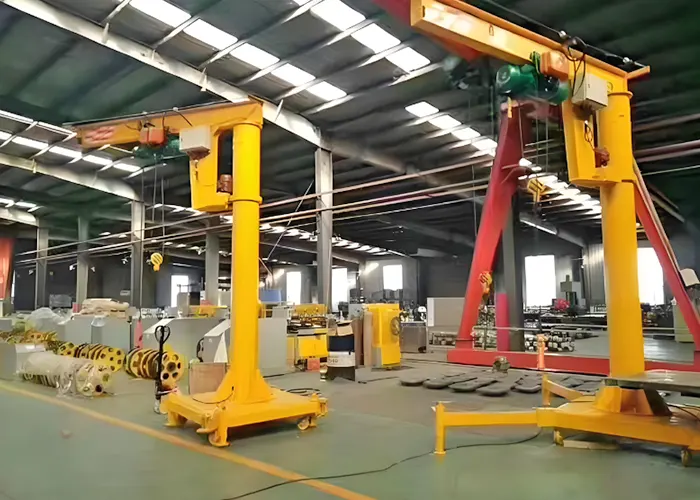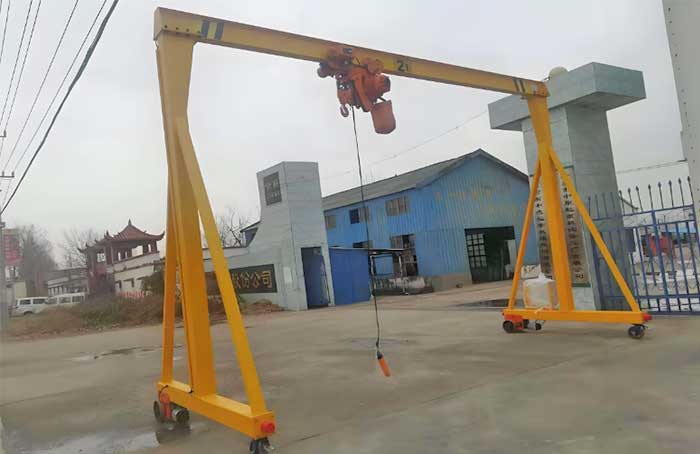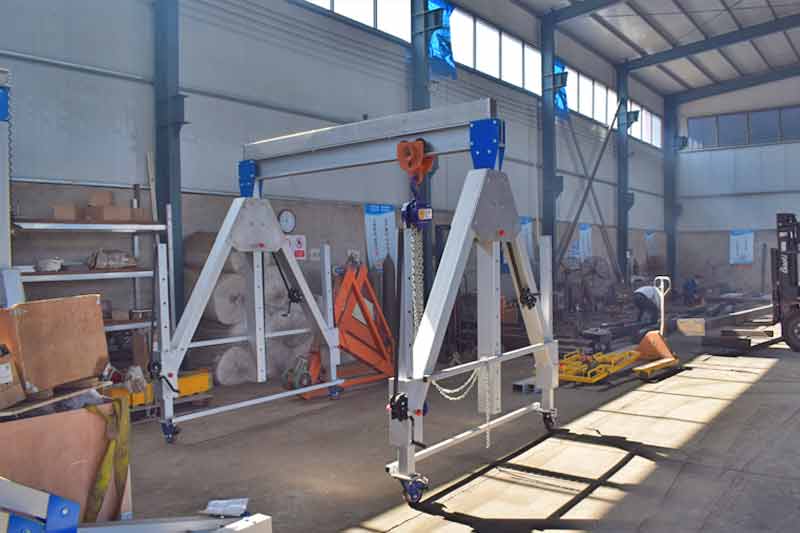Small Portable Crane Lifting Equipment: Tools for Precision in Small Workspaces
Portable Crane Lifting Equipment
Small portable crane lifting equipment is designed to provide effective lifting solutions in areas where space is limited. These cranes are typically compact, lightweight, and easy to maneuver, making them ideal for various applications in small workspaces, such as workshops, construction sites, and maintenance areas. The primary purpose of these cranes is to facilitate the safe and efficient lifting of heavy loads, allowing operators to handle materials and equipment with precision.
Precision lifting is particularly important in confined spaces, where there is often limited room to navigate. In these environments, the risk of accidents increases, and the need for accuracy in positioning is paramount. Small portable cranes enable operators to lift and place materials with greater control, reducing the likelihood of mishaps and enhancing overall workplace safety. The ability to lift loads accurately is not just about convenience; it can significantly impact productivity and operational efficiency.
Significance of Specialized Lifting Equipment
Specialized lifting equipment, such as small portable cranes, plays a critical role in improving safety and efficiency during lifting operations. These tools are engineered to meet specific requirements, ensuring they can handle various lifting tasks safely. By using equipment that is tailored to the job, operators can minimize the risk of injury and equipment damage.
For instance, many small cranes are equipped with features like adjustable height mechanisms and precision control systems, which enhance their functionality in tight spaces. These features allow for better load management, ensuring that materials are lifted and moved accurately without causing accidents.
The applications of specialized lifting equipment span multiple industries, including construction, manufacturing, automotive repair, and even home improvement. In construction, portable cranes can assist in lifting heavy materials to elevated positions where traditional cranes may not fit. In manufacturing, they are invaluable for moving components along assembly lines or lifting heavy machinery for repairs. By understanding the significance of these specialized tools, businesses can enhance their operational capabilities and improve workplace safety.
Types of Small Portable Crane Lifting Equipment
When it comes to small portable crane lifting equipment, there are several types designed to meet the needs of various industries and applications. Each type offers unique features that enhance its functionality in tight spaces. Below are some of the most common small portable cranes and their specific attributes.
Small Portable Jib Cranes
- Description of Design and Functionality: Small portable jib cranes are characterized by their horizontal arm (jib) that extends from a vertical post. This design allows for a rotating lifting point, making it easy to maneuver loads in tight spaces. They can be fixed to the ground or mounted on a wheeled base for added mobility.
- Benefits for Precise Lifting in Tight Spaces: The key advantage of jib cranes is their ability to provide precise lifting and positioning capabilities. They can lift loads directly overhead, minimizing the risk of collisions in confined work areas. This makes them ideal for tasks such as lifting heavy components in workshops or facilitating assembly processes.

Small Portable Gantry Cranes
- Variations in Design: Adjustable and Fixed Height: Small portable gantry cranes come in various designs, including adjustable and fixed height options. Adjustable gantry cranes allow users to modify the height according to the specific lifting requirements, while fixed gantry cranes provide stability for consistent lifting tasks. Both types are typically constructed from lightweight materials for ease of transport.
- Use Cases in Workshops and Manufacturing: Gantry cranes are versatile and can be used for a wide range of applications, such as moving heavy parts in manufacturing facilities, lifting engines in automotive repair shops, or handling materials in warehouses. Their ability to span a distance while lifting from a specific point allows for efficient load handling without the need for extensive setup.

Small Portable Aluminum Cranes
- Description and Advantages: Small portable aluminum cranes are designed for lightweight lifting applications. They are made from durable aluminum, making them both strong and easy to transport. These cranes are particularly useful for situations where weight is a critical factor, such as in automotive or marine environments.
- Applications and Load Capacities: Typically capable of lifting loads up to 1 ton, aluminum cranes are favored in scenarios where portability and ease of assembly are essential. They are commonly used in construction sites for lifting materials onto roofs or in workshops for moving heavy equipment.

Small Battery-Powered Cranes
- Description and Functionality: Small battery-powered cranes are equipped with electric hoists that are powered by rechargeable batteries. This feature makes them convenient for use in locations without access to power outlets. These cranes are designed to be compact and user-friendly, often featuring remote controls for enhanced operation.
- Benefits and Applications: Battery-powered cranes provide the benefit of mobility and versatility, allowing for lifting tasks in various environments without being tethered to a power source. They are ideal for small construction projects, maintenance work, and even indoor applications where traditional power sources may be impractical.
In summary, the diversity of small portable crane lifting equipment, from mini cranes to battery-powered options, ensures that businesses can find the right solution for their specific lifting needs, enhancing efficiency and safety in small workspaces.
Key Features of Portable Crane Lifting Tools
When choosing portable crane lifting tools, understanding their key features is essential for ensuring safety, efficiency, and suitability for various lifting tasks in small workspaces. The following sections detail these important characteristics:
Adjustable Height Mechanisms
Adjustable height mechanisms are a crucial feature of portable cranes, allowing users to customize the crane's height to suit specific lifting tasks.
- Flexibility for Various Tasks: The ability to adjust the crane height means it can be used for different applications, whether lifting materials from the ground or positioning items overhead. This flexibility is especially beneficial in environments with varying ceiling heights or obstacles.
- Improved Precision: By adjusting the height, operators can achieve better load placement, minimizing the risk of collisions and ensuring materials are positioned accurately.
- User-Friendly Design: Many cranes incorporate easy-to-use height adjustment mechanisms, such as manual cranks or pneumatic systems, allowing quick changes without extensive setup.
Precision Control Systems
Precision control systems enhance the operator's ability to position loads accurately, making them essential for effective crane operations.
Control Mechanisms: Most portable cranes feature advanced control options, including:
- Remote Controls: Allowing operators to lift and lower loads from a safe distance.
- Joystick Controls: Providing precise maneuverability in multiple directions.
- Programmable Settings: Enabling operators to set specific lifting parameters for repeated tasks.
Safety and Efficiency: These control systems reduce the risk of accidents by allowing operators to navigate around obstacles smoothly and place loads precisely where needed, improving overall workflow.
Enhanced Responsiveness: Modern cranes often come with sensitivity settings that let operators adjust the lifting speed, ensuring that even delicate items are handled with care.
Lightweight and Compact Design
Lightweight and compact designs are vital for portability and ease of use, making these cranes ideal for small workspaces.
- Material Composition: Many portable cranes are constructed from high-strength materials like aluminum or reinforced steel, balancing durability and weight. This design ensures that the cranes can support significant loads while remaining manageable.
- Mobility: The lightweight nature of these cranes facilitates easy transport, allowing operators to move them between job sites or reposition them within a workspace without heavy machinery.
- Storage Convenience: Their compact size means they can be stored easily in small workshops, garages, or construction sites, minimizing clutter and freeing up space for other equipment.
Safety Features
Safety features are critical in portable cranes to protect both operators and the loads being handled.
- Overload Protection: Most cranes are equipped with overload protection systems that prevent lifting beyond the specified weight limit. This feature is essential for avoiding mechanical failures and accidents.
- Emergency Stops: Integrated emergency stop buttons allow operators to halt operations immediately if a situation arises, ensuring quick response in emergencies.
- Safety Locks and Limit Switches: These mechanisms prevent unintended movements and ensure that the crane operates within designated safety parameters. For instance, limit switches can stop the crane at predetermined heights, preventing collisions with overhead structures.
- Regular Safety Inspections: Operators should regularly inspect these safety features to ensure they are functional and compliant with safety regulations.
Versatility and Compatibility
The versatility of portable crane lifting tools is one of their most valuable characteristics, allowing them to be used in a wide range of applications.
Compatibility with Accessories: Many portable cranes can be used with various lifting accessories, including:
- Hooks and Slings: For attaching loads securely.
- Hoists: To enhance lifting capabilities.
- Suction Cups: For handling glass or other smooth surfaces.
Adaptability to Different Tasks: This compatibility allows operators to adapt the crane for specific tasks, whether lifting heavy machinery in a workshop or moving building materials on a construction site.
Multi-Functional Use: The ability to switch out accessories makes these cranes ideal for businesses with diverse operational needs, enabling them to handle various lifting scenarios efficiently.
In summary, the key features of portable crane lifting tools, including adjustable height mechanisms, precision control systems, lightweight designs, robust safety features, and versatility, contribute significantly to their effectiveness in small workspaces. Understanding these features helps operators choose the right crane for their lifting needs, ensuring safety and operational efficiency.
Benefits of Using Small Portable Crane Lifting Equipment
Utilizing small portable crane lifting equipment offers numerous advantages that enhance lifting operations, especially in confined spaces. These benefits encompass precision, safety, efficiency, and cost-effectiveness, making them valuable tools for various industries.
Enhanced Precision in Lifting Operations
Small portable cranes are specifically designed to provide enhanced precision in lifting tasks, which can significantly improve operational outcomes.
Case Studies Showcasing Successful Precision Lifts:
- In the automotive industry, a portable jib crane was used to lift and position engine components in a tight assembly line. The adjustable height feature allowed operators to position the engine precisely, reducing assembly time by 15%.
- A construction project involving the installation of HVAC systems in a high-rise building benefited from a small gantry crane. Its precision control system enabled workers to navigate around obstacles, ensuring that the units were installed accurately and without damage.
Increased Safety in Confined Spaces
Safety is paramount in any lifting operation, particularly in confined spaces where the risk of accidents is heightened.
Statistics on Accidents and Safety Improvements:
- According to the Occupational Safety and Health Administration (OSHA), incidents involving cranes accounted for approximately 22% of construction fatalities in previous years. However, the use of portable cranes with integrated safety features, such as overload protection and emergency stops, has shown to reduce these incidents significantly.
- A study conducted in a manufacturing facility reported a 30% decrease in workplace injuries after implementing portable cranes with robust safety mechanisms. Operators found that they could perform lifting tasks more confidently, knowing that the equipment was designed to minimize risks.
Improved Efficiency and Productivity
Small portable crane lifting equipment plays a crucial role in streamlining operations and enhancing productivity in various settings.
How Specialized Tools Streamline Operations:
- Portable cranes facilitate faster lifting and positioning of loads, allowing workers to complete tasks more quickly. For example, in warehouses, using a portable gantry crane can speed up the process of moving heavy pallets, increasing throughput by 25%.
- The user-friendly design of portable cranes often requires less training for operators, enabling teams to become proficient more quickly. This reduces downtime and ensures that projects progress without delays.
Cost-Effectiveness
Investing in small portable crane lifting equipment can lead to significant long-term savings for businesses.
Long-Term Savings Through Reduced Labor Costs and Injuries:
- By enhancing precision and safety, portable cranes reduce the likelihood of accidents and injuries, which can lead to costly workers' compensation claims. For instance, companies that have adopted portable cranes reported a 40% reduction in injury-related costs.
- Additionally, the efficiency gained from using specialized lifting equipment translates to lower labor costs. Workers can complete tasks more rapidly, reducing the overall man-hours required for projects. This efficiency not only saves money but also allows businesses to take on more projects within the same timeframe.
In conclusion, the benefits of using small portable crane lifting equipment extend beyond mere convenience. Enhanced precision, increased safety, improved efficiency, and cost-effectiveness make these cranes invaluable tools for businesses operating in confined spaces. By leveraging these advantages, organizations can optimize their lifting operations and ultimately achieve better outcomes.
Applications of Portable Crane Lifting Equipment
Small portable crane lifting equipment is versatile and finds applications across various industries. These cranes enhance operational capabilities in construction, automotive repair, manufacturing, and even home improvement projects. Here’s a closer look at how they are utilized in different settings:
Construction and Renovation
In the construction and renovation sectors, portable cranes play a vital role in handling materials and equipment in often confined and challenging environments.
Specific Tasks Where Portable Cranes Excel:
- Lifting Heavy Beams and Steel Frames: Portable cranes can easily lift and position heavy structural elements, such as beams and steel frames, during the construction of buildings and bridges.
- Installing Roofs and HVAC Systems: They are invaluable for installing roofing materials and HVAC units in hard-to-reach areas, allowing for precise placement without requiring extensive scaffolding.
- Demolition Projects: In renovation tasks, portable cranes assist in safely removing heavy debris and materials, making the process more efficient and reducing manual labor risks.
Automotive Repair Shops
Portable cranes are essential tools in automotive repair shops, where they assist mechanics in lifting and maneuvering heavy components.
Use in Lifting and Maneuvering Heavy Components:
- Engine Removal and Installation: Mechanics often use portable cranes to lift engines out of vehicles for repair or replacement, providing the strength needed while ensuring safety.
- Transmission Handling: Portable cranes are also employed to remove and install transmissions, which can be bulky and heavy, making manual handling risky.
- Parts Organization: In busy repair environments, portable cranes help organize and lift heavy parts, streamlining workflows and ensuring that the necessary components are readily accessible.
Manufacturing Facilities
In manufacturing facilities, precision is crucial, and portable cranes significantly enhance efficiency in various applications.
Precision Lifting in Assembly Lines and Workshops:
- Assembly Line Operations: Portable cranes facilitate the movement of parts along assembly lines, allowing for precise positioning that minimizes the risk of damage and errors.
- Material Handling: They are often used to lift raw materials and components in workshops, enhancing productivity by enabling quick and safe transfers between workstations.
- Quality Control: Portable cranes can assist in the inspection of large components by lifting them to optimal viewing heights for quality checks, ensuring that products meet industry standards.
Home and DIY Projects
Portable crane lifting equipment is not just for professionals; they are also accessible for homeowners and DIY enthusiasts looking to tackle projects safely and effectively.
Accessibility for Non-Professionals in Home Improvement Tasks:
- Heavy Lifting in Renovations: Homeowners can use portable cranes to lift heavy items like furniture, appliances, and construction materials, making home renovation projects more manageable.
- Gardening and Landscaping: These cranes can assist in lifting and positioning heavy rocks, planters, or garden structures, allowing individuals to create beautiful outdoor spaces without excessive strain.
- Ease of Use: Many portable cranes are designed for ease of use, making them suitable for non-professionals. User-friendly features allow DIYers to operate them safely and effectively, encouraging more people to take on ambitious projects.
In summary, portable crane lifting equipment serves a diverse range of applications across various industries. From construction and automotive repair to manufacturing and home improvement, these cranes enhance operational capabilities, making tasks safer and more efficient. Their versatility and accessibility ensure they remain invaluable tools in both professional and personal settings.
Best Practices for Using Portable Crane Lifting Tools
To maximize the effectiveness and safety of portable crane lifting tools, adhering to best practices is essential. This ensures that operators can work efficiently while minimizing risks. Here are some key best practices to follow when using portable cranes:
Proper Training and Certification
Operator training is crucial for ensuring safety and efficiency during lifting operations.
Importance of Operator Training for Safety and Efficiency:
- Comprehensive Training Programs: Operators should undergo formal training that covers the specific types of portable cranes they will be using. This includes understanding the equipment's features, load capacities, and operational procedures.
- Certification Requirements: Many regions require operators to be certified to operate cranes safely. Certification programs often include both theoretical knowledge and practical assessments, ensuring operators are well-equipped to handle the equipment.
- Ongoing Training: Regular refresher courses and updates on new safety practices and technologies help maintain operator competency and awareness of potential hazards.
Regular Maintenance and Inspections
Routine maintenance and inspections are critical for prolonging the lifespan of portable cranes and ensuring they operate safely.
Guidelines for Maintaining Equipment Longevity:
- Daily Pre-Operational Checks: Operators should perform daily inspections before use, checking for signs of wear, loose bolts, and fluid leaks. This helps identify potential issues before they lead to failures during operation.
- Scheduled Maintenance: Follow the manufacturer's recommendations for regular maintenance schedules, which may include lubrication, replacing worn parts, and testing safety features.
- Documenting Inspections: Keeping detailed records of inspections and maintenance activities helps track the equipment’s condition over time and is often required for compliance with safety regulations.
Adhering to Safety Standards
Following safety standards is essential for protecting both operators and bystanders during crane operations.
Overview of Relevant Safety Regulations and Practices:
- Compliance with OSHA Standards: In the United States, the Occupational Safety and Health Administration (OSHA) provides guidelines that must be followed for crane operations, including load limits, stability, and operator qualifications.
- Use of Personal Protective Equipment (PPE): Operators and personnel in the vicinity of lifting operations should wear appropriate PPE, such as hard hats, safety glasses, and gloves, to protect against potential hazards.
- Establishing Clear Communication: Implementing a communication plan that includes hand signals or two-way radios helps ensure that all team members are aware of ongoing lifting operations and can respond quickly to any issues that arise.
By implementing these best practices—proper training and certification, regular maintenance and inspections, and adherence to safety standards—operators can significantly enhance the safety and efficiency of portable crane lifting operations. These measures not only protect the workers involved but also contribute to the overall success of lifting tasks in various environments.
Conclusion: Customized Small Portable Crane Lifting Equipment
In conclusion, small portable crane lifting equipment plays a vital role in enhancing the efficiency and safety of lifting operations across various industries. Their design and functionality make them particularly suited for use in confined spaces, allowing for precision lifting that meets the demands of modern work environments.
Importance of Small Portable Crane Lifting Equipment:
- Versatility Across Applications: From construction and automotive repair to manufacturing and home improvement, portable cranes are essential tools that facilitate heavy lifting tasks while improving workflow and productivity.
- Enhanced Safety and Precision: These cranes significantly reduce the risks associated with manual lifting and maneuvering of heavy components, showcasing their value in maintaining safety standards and ensuring accurate positioning of loads.
- Best Practices for Optimal Use: Emphasizing proper training, regular maintenance, and adherence to safety regulations ensures that portable crane operations are conducted safely and efficiently, maximizing their benefits.
The integration of small portable cranes into various work environments not only streamlines operations but also fosters a culture of safety and efficiency. As industries continue to evolve, the importance of specialized lifting equipment will remain paramount, ensuring that businesses can meet the challenges of today’s demanding operational landscape.




